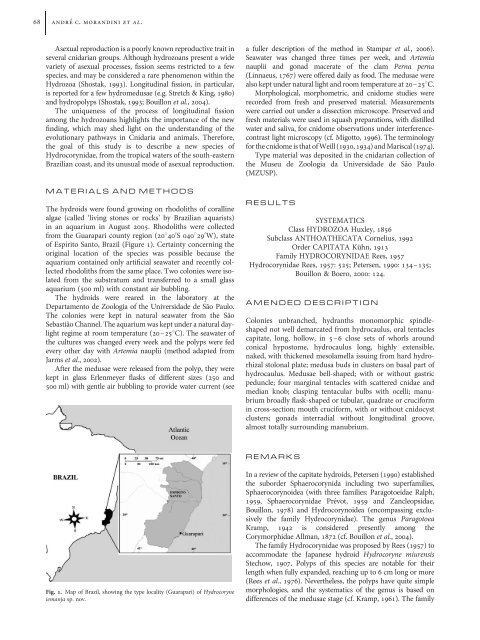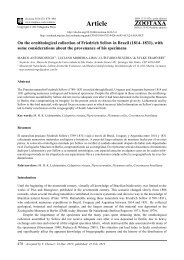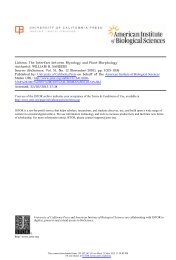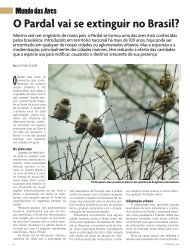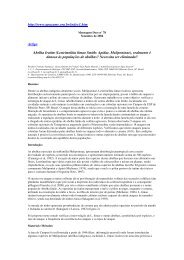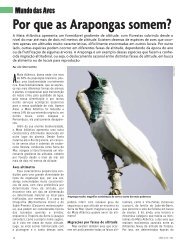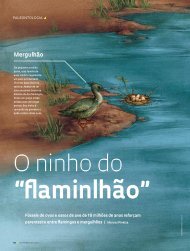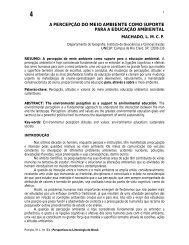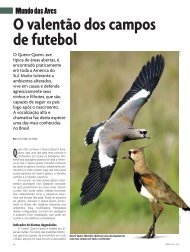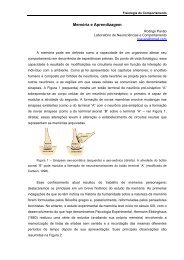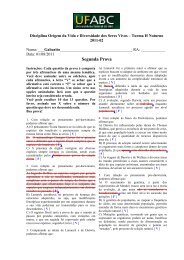Hydrocoryne iemanja (Cnidaria) - Instituto de Biociências - USP
Hydrocoryne iemanja (Cnidaria) - Instituto de Biociências - USP
Hydrocoryne iemanja (Cnidaria) - Instituto de Biociências - USP
Create successful ePaper yourself
Turn your PDF publications into a flip-book with our unique Google optimized e-Paper software.
68 andre c.morandiniet al.<br />
Asexual reproduction is a poorly known reproductive trait in<br />
several cnidarian groups. Although hydrozoans present a wi<strong>de</strong><br />
variety of asexual processes, fission seems restricted to a few<br />
species, and may be consi<strong>de</strong>red a rare phenomenon within the<br />
Hydrozoa (Shostak, 1993). Longitudinal fission, in particular,<br />
is reported for a few hydromedusae (e.g. Stretch & King, 1980)<br />
and hydropolyps (Shostak, 1993; Bouillon et al., 2004).<br />
The uniqueness of the process of longitudinal fission<br />
among the hydrozoans highlights the importance of the new<br />
finding, which may shed light on the un<strong>de</strong>rstanding of the<br />
evolutionary pathways in <strong>Cnidaria</strong> and animals. Therefore,<br />
the goal of this study is to <strong>de</strong>scribe a new species of<br />
Hydrocorynidae, from the tropical waters of the south-eastern<br />
Brazilian coast, and its unusual mo<strong>de</strong> of asexual reproduction.<br />
MATERIALS AND METHODS<br />
The hydroids were found growing on rhodoliths of coralline<br />
algae (called ‘living stones or rocks’ by Brazilian aquarists)<br />
in an aquarium in August 2005. Rhodoliths were collected<br />
from the Guarapari county region (20840 0 S 040829 0 W), state<br />
of Espírito Santo, Brazil (Figure 1). Certainty concerning the<br />
original location of the species was possible because the<br />
aquarium contained only artificial seawater and recently collected<br />
rhodoliths from the same place. Two colonies were isolated<br />
from the substratum and transferred to a small glass<br />
aquarium (500 ml) with constant air bubbling.<br />
The hydroids were reared in the laboratory at the<br />
Departamento <strong>de</strong> Zoologia of the Universida<strong>de</strong> <strong>de</strong> São Paulo.<br />
The colonies were kept in natural seawater from the São<br />
Sebastião Channel. The aquarium was kept un<strong>de</strong>r a natural daylight<br />
regime at room temperature (20–258C). The seawater of<br />
the cultures was changed every week and the polyps were fed<br />
every other day with Artemia nauplii (method adapted from<br />
Jarms et al., 2002).<br />
After the medusae were released from the polyp, they were<br />
kept in glass Erlenmeyer flasks of different sizes (250 and<br />
500 ml) with gentle air bubbling to provi<strong>de</strong> water current (see<br />
a fuller <strong>de</strong>scription of the method in Stampar et al., 2006).<br />
Seawater was changed three times per week, and Artemia<br />
nauplii and gonad macerate of the clam Perna perna<br />
(Linnaeus, 1767) were offered daily as food. The medusae were<br />
also kept un<strong>de</strong>r natural light and room temperature at 20–258C.<br />
Morphological, morphometric, and cnidome studies were<br />
recor<strong>de</strong>d from fresh and preserved material. Measurements<br />
were carried out un<strong>de</strong>r a dissection microscope. Preserved and<br />
fresh materials were used in squash preparations, with distilled<br />
water and saliva, for cnidome observations un<strong>de</strong>r interferencecontrast<br />
light microscopy (cf. Migotto, 1996). The terminology<br />
for the cnidome is that of Weill (1930, 1934) and Mariscal (1974).<br />
Type material was <strong>de</strong>posited in the cnidarian collection of<br />
the Museu <strong>de</strong> Zoologia da Universida<strong>de</strong> <strong>de</strong> São Paulo<br />
(MZ<strong>USP</strong>).<br />
RESULTS<br />
SYSTEMATICS<br />
Class HYDROZOA Huxley, 1856<br />
Subclass ANTHOATHECATA Cornelius, 1992<br />
Or<strong>de</strong>r CAPITATA Kühn, 1913<br />
Family HYDROCORYNIDAE Rees, 1957<br />
Hydrocorynidae Rees, 1957: 525; Petersen, 1990: 134–135;<br />
Bouillon & Boero, 2000: 124.<br />
AMENDED DESCRIPTION<br />
Colonies unbranched, hydranths monomorphic spindleshaped<br />
not well <strong>de</strong>marcated from hydrocaulus, oral tentacles<br />
capitate, long, hollow, in 5–6 close sets of whorls around<br />
conical hypostome, hydrocaulus long, highly extensible,<br />
naked, with thickened mesolamella issuing from hard hydrorhizal<br />
stolonal plate; medusa buds in clusters on basal part of<br />
hydrocaulus. Medusae bell-shaped; with or without gastric<br />
peduncle; four marginal tentacles with scattered cnidae and<br />
median knob; clasping tentacular bulbs with ocelli; manubrium<br />
broadly flask-shaped or tubular, quadrate or cruciform<br />
in cross-section; mouth cruciform, with or without cnidocyst<br />
clusters; gonads interradial without longitudinal groove,<br />
almost totally surrounding manubrium.<br />
REMARKS<br />
Fig. 1. Map of Brazil, showing the type locality (Guarapari) of <strong>Hydrocoryne</strong><br />
<strong>iemanja</strong> sp. nov.<br />
In a review of the capitate hydroids, Petersen (1990) established<br />
the subor<strong>de</strong>r Sphaerocorynida including two superfamilies,<br />
Sphaerocorynoi<strong>de</strong>a (with three families: Paragotoeidae Ralph,<br />
1959, Sphaerocorynidae Prévot, 1959 and Zancleopsidae,<br />
Bouillon, 1978) and Hydrocorynoi<strong>de</strong>a (encompassing exclusively<br />
the family Hydrocorynidae). The genus Paragotoea<br />
Kramp, 1942 is consi<strong>de</strong>red presently among the<br />
Corymorphidae Allman, 1872 (cf. Bouillon et al., 2004).<br />
The family Hydrocorynidae was proposed by Rees (1957) to<br />
accommodate the Japanese hydroid <strong>Hydrocoryne</strong> miurensis<br />
Stechow, 1907. Polyps of this species are notable for their<br />
length when fully expan<strong>de</strong>d, reaching up to 6 cm long or more<br />
(Rees et al., 1976). Nevertheless, the polyps have quite simple<br />
morphologies, and the systematics of the genus is based on<br />
differences of the medusae stage (cf. Kramp, 1961). The family


